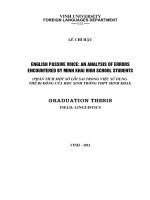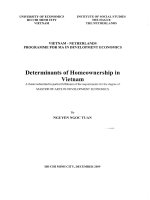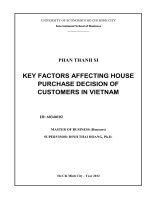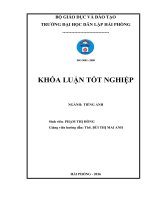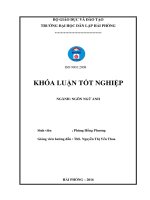1206 Determinants of consumer loan repayment performance of customers in Vietnam prosperity banks Huynh Tan Phat Branch Khóa luận tốt nghiệp Đại học Nguyen.docx
Bạn đang xem bản rút gọn của tài liệu. Xem và tải ngay bản đầy đủ của tài liệu tại đây (473.93 KB, 68 trang )
MINISTRY OF EDUCATION AND TRAINING
STATE BANK OF VIETNAM
BANKING UNIVERSITY HO CHI MINH CITY
NGUYEN THI THU UYEN
DETERMINANTS OF CONSUMER LOAN
REPAYMENT PERFORMANCE OF CUSTOMERS IN
VIETNAM PROSPERITY BANK HUYNH TAN PHAT BRANCH
MAJOR: FINANCING AND BANKING
MAJOR NUMBER: 7340201
GRADUATION THESIS
HO CHI MINH - 2018
MINISTRY OF EDUCATION AND TRAINING
STATE BANK OF VIETNAM
BANKING UNIVERSITY HO CHI MINH CITY
NGUYEN THI THU UYEN
DETERMINANTS OF CONSUMER LOAN
REPAYMENT PERFORMANCE OF CUSTOMERS IN
VIETNAM PROSPERITY BANK HUYNH TAN PHAT BRANCH
MAJOR: FINANCING AND BANKING
MAJOR NUMBER: 7340201
GRADUATION THESIS
SUPERVISOR: Assoc. Prof. PhD. HA THI THIEU DAO
HO CHI MINH - 2018
i
DECLARATION OF AUTHENCITY
Full name: Nguyen Thi Thu Uyen
Student class: HQ02-GE01, faculty of Banking and Finance, Banking University of Ho
Chi Minh city.
Student code: 030630140790
I declare that this thesis has been composed solely by myself and that it has not been
submitted, in whole or in part, in any previous application for a degree. Except where
states otherwise by reference or acknowledgment, the work presented is entirely my
own.
Ho Chi Minh City, May 29th 2018
Author
Nguyen Thi Thu Uyen
ACKNOWLEDGEMENTS
First of all, I would like to thank all lecturers at Banking University of HCMC. Your
enthusiastic and devoted instruction helped me to improve my logical thinking ability
and knowledge.
In addition, I would like to thank Ms.Ha Thi Thieu Dao who enthusiastically instructed
and encouraged me to complete this graduation thesis.
However, due to limited knowledge and practical experience and limited research time,
the study cannot avoid certain shortcomings. The author wishes to receive the
comments of members in the committee to complete the thesis.
Ho Chi Minh City, May 29th 2018
Author
Nguyen Thi Thu Uyen
ABSTRACT
Author
UYEN, Thu Thi NGUYEN
Title
Determinants of consumer loan repayment performance in
VPBank Huynh Tan Phat Branch
Language
English
Instructor
DAO, Thieu Thi HA
Banking credit plays a very important role in the economy of every country in the
world and is especially important for countries with underdeveloped financial markets
like Vietnam because it is a main source of funding for not only businesses but also
personal customers. In the process of international integration, competition among
commercial banks will make the banking system more efficient and effective.
However, this also makes banks tend to loosen their credit policies, lowering lending
conditions, resulting in evaluating incorrectly customers‟ repayment probability,
particularly in the consumer loan segment. Minimizing customers to incur an overdue
debt or even loss of solvency is always a challenge which requires commercial banks
need to pay attention and also find solutions to apply to the management. This thesis
examines determinants of consumer loan repayment performance of customers in
Vietnam Prosperity Bank Huynh Tan Phat Branch. Quantitative approaches are
applied, in which Logit model is employed to investigate probability of consumer loan
be repaid. The results express that the factors including career characteristics, income,
ratio of collateral on loan size, the number of dependent people, credit history as well
as purpose of taking loan will affect the probability of consumer customers ‟ loan
repayment in the bank. A number of recommendations are introduced to promote the
repayment performance of these borrowers.
Key words: Consumer loans, Consumer customers, Logistics model, Probability of
repayment, VPBank Huynh Tan Phat.
TABLE OF CONTENTS
LIST OF TABLE AND FIGURES............................................................................vii
LIST OF ACRONYMS............................................................................................. viii
CHAPTER 1: INTRODUCTION................................................................................ 1
1.1. Research background........................................................................................... 1
1.2. The necessity of the topic..................................................................................... 2
1.3. Research objectives.............................................................................................. 4
1.4. Research question................................................................................................. 4
1.5. Subject and Scope of research.............................................................................. 5
1.5.1. Subject of study............................................................................................. 5
1.5.2. Scope of study................................................................................................ 5
1.6. Analytical methods............................................................................................... 5
1.7. Contributions of research..................................................................................... 5
1.8. Thesis structure.................................................................................................... 6
CHAPTER 2: LITERATURE REVIEW AND FACTORS AFFECTING THE
REPAYMENT OF CONSUMER BORROWERS IN COMMERCIAL BANKS.............7
2.1. Literature review on consumer loans.................................................................... 7
2.1.1. Consumer loan definition............................................................................... 7
2.1.2. Consumer loan features.................................................................................. 8
2.2. Factors affecting the repayment of consumer borrowers...................................... 9
2.2.1. Definition of consumer loan repayment....................................................... 11
2.2.2. Previous experimental studies on determinants of loan repayment
performance........................................................................................................... 11
2.3. Aggregation of factors affecting customers‟ consumer loan repayment............15
CHAPTER 3: DATA AND METHODOLOGY....................................................... 20
3.1. Models researching consumer loan repayment performance.............................. 20
3.1.1. Model 5C..................................................................................................... 20
3.1.2. Binary Logistics Regression model.............................................................. 22
3.1.2.1. Multicollinearity testing............................................................................ 25
3.1.2.2. Testing the fiting of model........................................................................ 25
3.1.2.3. Testing the statistical significance of the coefficients...............................26
3.2. Research model at VPBank Huynh Tan Phat..................................................... 27
3.2.1. Data collection............................................................................................. 27
3.2.2.. Logit regression model................................................................................ 28
CHAPTER 4: RESEARCH RESULT....................................................................... 32
4.1. Consumer loan in Vietnam Prosperity Bank Huynh Tan Phat Branch................32
4.2. Descriptive statistic results................................................................................. 35
4.3. Research results.................................................................................................. 39
CHAPTER 5: CONCLUSION, RECOMMENDATIONS AND LIMITATIONS 48
5.1. Conclusion and Recommendations..................................................................... 48
5.1.1. Group of positive effects.............................................................................. 48
5.1.2. Group of negative effects............................................................................. 49
5.1.3. Other recommendations............................................................................... 50
5.2. Limitations and suggestions for further researches............................................. 52
REFERENCES........................................................................................................... 54
APPENDIX................................................................................................................. 57
LIST OF TABLES AND FIGURES
Name
Page
Table 2.1: Research models relating to the subject.......................................................14
Table 2.2: Main determinants of consumer loan repayment performance.....................18
Table 3.1: Analyze sample data according to consumer repayment..............................27
Table 3.2: Variables in the research model....................................................................30
Table 4.1: Consumer loans classified by purpose of borrowing....................................35
Table 4.2: Classification of consumer loan groups.......................................................36
Table 4.3: Descriptive Statistics....................................................................................37
Table 4.4: Correlation matrix of variables in model......................................................42
Table 4.5: Collinearity Statistics...................................................................................43
Table 4.6: Model Logistic with 8 variables...................................................................43
Table 4.7: Model Logistic with 6 variables...................................................................44
Table 4.8: Omnibus Tests of model coefficients...........................................................44
Table 4.9: Testing the fiting of model...........................................................................45
Table 4.10: Testing accuracy level of model.................................................................45
Table 4.11: Logistic regression result...........................................................................46
Table 4.12: Simulation of customer repayment probability..........................................46
Figure 4.1: Average income of customers.....................................................................40
LIST OF ACRONYMS
Abbreviations
Full meaning
CIs
Credit Institutions
CIC
Credit Information Center
KPI
Key Performance Indicator
IMF
International Monetary Fund
NPL
Non-performing loan
SPSS
Statistical package for Social Sciences
VND
Vietnam Dong
VPBank
Vietnam Prosperity Bank
VIF
Variance Inflation Factor
1
CHAPTER 1: INTRODUCTION
1.1.
Research background
In many countries in the whole world, consumer price index is considered as a
key signal of economic growth in the medium term. Consumption reflects people ‟s
expectations of future income. Even consumer demands such as cars, houses,
appliances or cosmetics are closely related each other and cannot be separated from the
expected income. This is also the driving force of production. Thus, consumer lending
has been deemed as an important business of retail banking for a long time. In 2015,
World Bank‟s survey also showed that although consumer lending accounted for only
30% to 35% of total loans, it generated over 60% of the commercial bank ‟s profit in
Asia in general and Vietnam banks in particular.
The total population in Vietnam was estimated at 92.7 million people along with
a per capita income of about $3,000 by 2020 (World Bank, 2018). In addition, the
market size has increased steadily with an annual average growth rate of over 6% in the
last 30 years. That is reason why Vietnam is considered as a very large consumer
market. High and sustainable incomes along with macroeconomic stability are two
essential factors for people to increase their consumer debt. The young population
structure with 70% of the population aged 15-64 is also a favorable aspect for the
development of consumer credit, as they are normally willing to borrow for spending.
The consumer credit market in Vietnam began to flourish in the last five years,
stemming from changes in consumer habits and high demand for property of middleincome class. Instead of accumulating enough money to buy their desired products,
people would like to satisfy their demand immediately by taking on loan and repay for
lenders later. Nowadays, borrowing from relatives, friends or the informal financial
market has gradually shifted to borrowing from financial institutions, such as banks.
This is an area with great potential for development in Vietnam by factors such as the
rapidly growing middle class, large consumer demand. With the development of
current technology, the type of institution serving the business development field is
very diverse and utility. Meanwhile, despite the rapid growth in recent years, the ratio
of consumer lending to total credit in Vietnam in comparison with the average ASEAN
countries is still only half (Vo Tri Thanh, 2018).
However, in the context of integration, besides some domestic commercial
banks, there have been many foreign banks (HSBC, SHINHAN BANK, ANZ, etc.) and
finance companies (HD SAISON, Home Credit, Prudential Finance, etc.), creating
fierce competitions. As the result, all banks are increasingly expanding their networks
and branches, diversifying their services and more importantly accelerating consumer
lending. Competition about consumer loans among finance companies and banks has
been hotter than ever. However, the outbreak of consumer credit, as a double-edged
sword, contains a lot of risks to the banking system and the profitability of each bank
as well. Even though banks are exposed to many types of risks, default risk is
considered to have the most influence on financial performance by far. If the risk is to
occur, the probability of capital loss is inevitable. Therefore, in order to limit the risk
arising from bad debts, it is necessary to understand the main factors leading to the
consumer loan repayment of customers.
1.2.
The necessity of the topic
Unlike corporate customers which banks can assess the probability to pay their
debt through specific financial criteria on the financial statements, the assessment of
consumer loan repayments much more difficult because it has not set up clear features
to assess repayment probability of customers. Therefore, the appraisal result is largely
dependent on capacity and subjective opinions of credit officers. The fact is that along
with the growth in consumer lending, bad debts in Vietnam banks have also increased
in recent years. In Vietnam, there are still many mistakes and restrictions that
consumer lending in banks and financial institutions has not developed strongly (Le
Thi Kim Hue, 2013).
Vietnam Prosperity Bank (VPBank) always attempts to improve its products
and services, and bring outstanding benefits to its customers. As a result, it became one
of the top-three retail Joint-Stock Commercial banks in Vietnam in 2017. Although,
consumer loan outstanding balance at VPBank in the period of 2014 to 2017
experienced an upward trend from 219,770 million VND to 341,180 million VND,
irrecoverable debts of consumer borrowers also increased from 0,797 million VND to
0.864 million VND. This rate is quite low and safe compared to the rate prescribed by
the State Bank but this is the sign that credit risk at VPBank tends to increase.
Particularly, when referring to changes in consumer credit activities at VPBank‟s
Branches and Transaction Offices, Huynh Tan Phat Branch is considered one of the
most remarkable places in the last two years. Especially, when researching consumer
credit activities at VPBank Huynh Tan Phat Branch, it can be said that this is actually a
“fertile land” bringing a relatively high profit for the bank. The branch is located in the
center of District 7 and surrounded by many apartments, automobile showrooms as
well as manufacturing areas. That is reason why the bank receives a large number of
consumer borrowers every year, from different industries (white-collar worker, bluecollar worker, etc.) to different purposes in using capitals (apartment, car or household
item purchase). However, lending to these customers became unstable and not as safe
as before in recent years. Due to since 2017, the real estate trading market in District 7
along with its neighboring areas such as Nha Be and Can Gio district have developed
rapidly. As a result, there has been an emergence of economic bubble, especially in the
high-end real estate segment (according to the leader of the State Bank of Ho Chi Minh
City Branch). Therefore, the appraisal and disbursement for real estate loans at
VPBank is more elaborate than ever. In addition, for customers who are blue-collar
workers, due to the unstable nature of work and income, their probability of repayment
is lower. Some foreign and Vietnamese authors were interested in doing research on
elements influencing loan repayment probability, such as Kenneth Ogol Ochung
(2013), Kohansal and Mansoori (2009), Nguyen Quang Nhat (2016), Le Thi Xuan
Nguyen (2013), Nguyen Duc Tu (2012), etc. but these studies only analyzed the factors
affecting the repayment of individual customers. Although in reality based on the
purpose of using loans, individual loans can be categorized into different types such as
consumer loans and business loans (Buzzell and Spasovski 2004). Depending on
distinct loan groups, the selection of research methods and factors affecting debt
repayment are also different. For these reasons mentioned above, there is a need to
examine the determinants of consumer loan repayment in Huynh Tan Phat Branch.
Overall, thanks to some statements of the thesis “Determinants of consumer loan
repayment performance in VPBank Huynh Tan Phat Branch”, the author hopes it
can help the bank appraise its customers better as well as prevent some potential risks
in the future.
1.3.
Research objectives
The thesis targets to:
Identify determinants of the repayment of consumer borrowers in VPBank
Huynh Tan Phat Branch.
Investigate influence level of these determinants on the repayment of consumer
borrowers in VPBank Huynh Tan Phat Branch.
Propose some solutions to improve the repayment probability of consumer
customers in VPBank Huynh Tan Phat Branch.
1.4.
Research questions
The research objectives can be achieved through answering these questions:
What are factors affecting the repayment of consumer borrowers in VPBank
Huynh Tan Phat Branch during the period of research?
How do these factors affect the consumer loan repayment of customers in
VPBank Huynh Tan Phat Branch?
1.5.
Subject and Scope of research
1.5.1. Subject of study
Determinants of consumer loan repayment performance of customers in
VPBank Huynh Tan Phat Branch.
1.5.2. Scope of study
In term of space: the consumer credit relationship at VPBank Huynh Tan Phat.
In term of time: the time spent studying factors affecting the repayment of
consumer borrowers is limited from January 2014 until December 2017.
1.6.
Analytical methods
The author selects 300 samples from data source such as home mortgage
applications, home equity applications, personal loan applications along with Finance
reports of VPBank Huynh Tan Phat Branch from January 2014 until 31 st December
2017.
Satistic, synthesis, comparison and analysis methods are applied for the thesis.
After aggregating available data, the author uses these data for comparison and
analysis by using Binary logistic regression model by SPSS software.
1.7.
Contributions of research
Theoretical contributions: The research was carried out in a spirit of inheritance
from the previous reports and researches on the existing theoretical
basis,
supplemented with empirical evidence in VPBank Huynh Tan Phat to enhance
understanding of factors affecting the repayment of consumer borrowers.
Practical contributions: The results not only help VPBank Huynh Tan Phat
appraise customers better before making a decision for consumer loans but also are
used as a data source in universities and other financial institutions.
1.8.
Thesis structure
Apart from the introduction and conclusion, the thesis has 5 chapters:
Chapter 1: Overview of Research.
Chapter 2: Giving out background of consumer loans, problems related to
consumer loans and collecting factors affecting the repayment of consumer borrowers
in commercial banks as well.
Chapter 3: Research Methods. Describes the research model, explains the
variables in the model.
Chapter 4: Testing determinants affecting consumer loan payment performance
of customers in VPBank Huynh Tan Phat
Chapter 5: Conclusion, solutions and recommendations for improving consumer
loan repayment probability. This chapter also outlines some limitations of research and
suggests new directions for further research.
CHAPTER 2: LITERATURE REVIEW AND FACTORS
AFFECTING THE REPAYMENT OF CONSUMER BORROWERS
IN COMMERCIAL BANKS
2.1. Literature review on consumer loans
2.1.1. Consumer loan definition
Consumption is a necessity of human beings. Consumption expenditures include
household goods purchase, vehicle purchase, house purchase, home repair, study
abroad as well as medical examination and treatment. Along with the development of
the economy, consumer demands of people are more diverse and increasing day by
day, leading to a lack of funding for their financial needs. Understanding that situation,
commercial banks have launched consumer lending products. So what is consumer
loan?
Consumer lending is an inevitable activity that is shaped by the demands of the
economy to address the problem of whether consumers have a need to shop beyond
their current solvency. Consumers are more likely to seek income from the loan. In
other words, consumer loans are loans intended to finance consumer spending,
including individuals and households. This is an important source of financing for
housing, household appliances, vehicles, education, health care, tourism, etc., before
they have enough financial power to enjoy (Le Thi Lan, 2016).
Consumer loan is a component of individual loan in commercial banks. It is also
called as consumer lending, consumer credit, or retail lending. There are many
concepts of consumer lending from a simple approach: “Consumer loan is to finance
the consumer‟s daily spending needs. This is an important source for people to cover
expenses for housing, home appliances, transportation, etc. In addition, spending on
education, health and tourism can also be sponsored by consumer loan “ or “Consumer
loan means a secured or unsecured loan given to customers for personal or family
purposes, or for consumable items such as a car, household applicans, etc. It is usually
given on the basis of borrower‟s credit history and ability to pay” (Le Van Tu, 2005).
Unlike banks from other countries, the majority of banks in Vietnam integrate real
estate loans as a form of consumer loans.
2.1.2. Consumer loan features
Consumer lending has the following characteristics (Wonder, 2008):
- The size of each loan is small (exclude real estate and some automobile loans)
but the quantity of loans is high. Therefore, transaction records are often large but sales
are low. With a large number of customers along with a wide distribution network, it is
necessary for every bank to open more branches, transaction offices and improve the
quality of Internet banking.
- Consumer loans are often riskier than business loans. Therefore, consumer
lending rates are also higher than that of other loans.
- Demand for consumer loans depends on the economic cycle. As the economy
grows steadily, demand for consumer loans will increase rapidly. Conversely, if the
economy experiences a downward trend or recession, this activity will decrease.
- Demand for consumer loans is almost unrelated to interest rates. Most
borrowers are more concerned about the amount of money they pay than the interest
they pay. In addition, because the loan amount is usually small, the distance of interest
rates does not make the interest payments monthly much different. Borrowers often
pay attention to how much the bank lends on collateral or their income.
- The borrower‟s principal source of repayment can vary greatly depending on
the work process, skills, working experience, and level of job stability.
- The goodwill of the borrower in loan repayment is difficult to determine, but it
is still an important criteria to evaluate the repayment probability of customers.
2.2. Factors affecting the repayment of consumer borrowers
2.2.1. Definition of consumer loan repayment
Loan repayment is the ability of customers to repay their consumer loans fully
and on time. There is currently no uniform definition of “consumer loan repayment”,
but there are indications show that customers are “unable to repay”. By the method of
exclusion, the remaining customers are able to repay the loan. A nonperforming loan
(NPL) is the sum of borrowed money upon which the debtor has not made his
scheduled payments for at least 90 days. A nonperforming loan is either in default or
close to being in default. Once a loan is nonperforming, the odds that it will be repaid
in full are considered to be substantially lower. According to International Monetary
Fund (2004) (IMF): “A loan is nonperforming when payments of interest and
principal are past due by 90 days or more, or at least 90 days of interest payments
have been capitalized, refinanced or delayed by agreement, or payments are less than
90 days overdue, but there are other good reasons to doubt that payments will be made
in full”.
A default is considered to have occurred with regard to a particular obligor
when either or both of the two following events have taken place:
- The bank considers that the obligor is unlikely to pay its credit obligations to the
banking group in full, without recourse by the bank to actions such as realising
security (if held).
- The obligor is past due more than 90 days on any material credit obligation to
the banking group.89 Overdrafts will be considered as being past due once the
customer has breached an advised limit or been advised of a limit smaller than current
outstanding” ( Basel Commitee on Banking Supervisor Article 452 2016).
Through the definition of IMF and indications that Basel II describes, incurring
bad debts means that customers are incapable of repaying their debts. In Vietnam,
Clause 8, Article 3, Chapter 1 Circular No. 02/2013 / TT-NHNN stipulate that NPL
means a debt which has been classified in Groups 3, 4 and 5. Specifically, Article 10,
Section 1, Chapter 2 clearly defines debt groups as follows:
-
Group 1 (standard debts) includes: Current debts that being assessed as fully and
timely recoverable, both principals and interests; Debts which are overdue for a period
of less than 10 days and being assessed as fully recoverable, both overdue principals
and interests, and fully and timely recoverable, both remaining principals and interests.
-
Group 2 (debts, which need attention) includes: Debts which are overdue for a
period of between 10 days and 90 days; Debts which are restructured repayment term
for the first time.
-
Group 3 (sub-standard debts) includes: Debts which are overdue for a period of
between 91 days and 180 days; Debts which are extended repayment term for the first
time; Debts which are exempted or reduced interests because customers are not
sufficient capability to pay all interests under credit contracts; Debts which are
recovered under inspection conclusions.
-
Group 4 (doubtful debts) includes: Debts which are overdue for a period of
between 181 days and 360 days; Debts which are restructured repayment term for the
first time but still overdue for a period of less than 90 days under that restructured
repayment term; Debts which are restructured repayment term for the second time;
Debts which must be recovered under inspection conclusions but fail to be repaid
although recovery term was overdue from 60 days ago.
-
Group 5 (potentially irrecoverable debts) includes: Debts which are overdue for
a period of more than 360 days; Debts which are restructured repayment term for the
first time but still overdue for a period of 90 days or more than under
that first restructured repayment term; Debts which are restructured repayment term for
the second time but still overdue under that second restructured repayment term; Debts
which are restructured repayment term for the third time or later, whether debts are
overdue or not; Debts which must be recovered under inspection conclusions but fail to
be repaid although recovery term was overdue for more than 60 days.
Thus, in order to unify the understanding of the whole thesis, consumer
borrowers having NPLs are considered as unpaid customers, while people with debts in
groups 1 and 2 are borrowers who have ability to repay debt.
2.2.2. Previous
experimental
studies
on
determinants
of
loan
repayment performance
Experimental research in the world evaluates the loan repayment in two main
aspects: size of repayment (the amount of principal along with interest is paid back)
and period of repayment. Some previous researches on consumer debt repayment have
focused on these factors, for example:
Maharjan et al. (1983) conducted a study on the repayment of farmers in Nepal
in the field of agricultural credit, including 150 farmers in 1982. The authors used a
multiple regression model as follows:
Y= f (X1, X2, X3, X4, D1, D2)
With:
Y: Amount paid on total loan
X1: Size of farm owned by farmer
X2: Farmer‟s income
X3: Percentage of farmers‟ products to total products in
market X4: Percentage of household expenditure on total
income
D1: Value = 1 if the loan is assessed before loan, 0 if the opposite
D2: Value = 1 if the loan is controlled for the right purpose, 0 if otherwise
The regression result shows that the larger the farm size or the higher the
household expenditure ratio is, the lower the debt repayment ratio is, while the other
variables are positive and statistically significant to debt repayment performance of
farmers.

